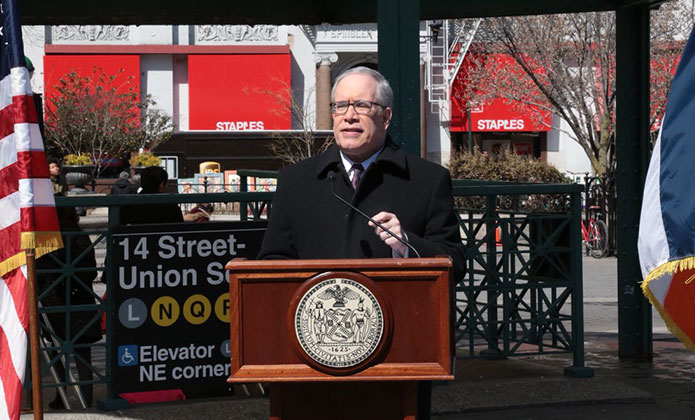Photo Courtesy of Comptroller Stringer’s Office
Comptroller Stringer called for increased subway service in the early morning and evening and for the City to immediately fund the Lhota emergency plan
By Forum Staff
Despite massive job growth in the last decade in the healthcare, hospitality, retail, restaurant, and entertainment industries, Metropolitan Transportation Authority subway service has failed to adapt to spiking ridership among those who don’t work a traditional 9 to 5, affecting lower-income, New Yorkers of color, and immigrants most, a recently released report by City Comptroller Scott Stringer revealed.
Stringer noted on Friday that “Left in the Dark: How the MTA is Failing to Keep Up with New York City’s Changing Economy” illustrates that while commuting patterns across the five boroughs have changed, especially between 5 a.m. and 7 a.m., subway service has not.
According to the report, those traveling to work off-peak now account for nearly half (47 percent) of all subway and bus commuters, up from 39 percent in 1990. In the last 25 years, the number of transit commuters departing for work outside of “traditional hours” soared by 39 percent, while the number of “traditional” commuters increased by 17 percent.
That means demand for off-peak service is rising faster than demand for rush-hour service.
However, as Stringer noted, subway service is dramatically diminished during early morning (5:30 a.m. to 6:30 a.m.) and later evening (8:30 p.m. to 10:30 p.m.) travel – when many service-sector workers depend on public transit. During these times: In the early morning, only 43 percent of train lines have wait times of less than 10 minutes, and zero have wait times of less than five minutes; in the evening, less than half of all subway lines maintain wait times of less than 10 minutes, and only 10 percent maintain frequencies of less than five minutes.
Stringer pointed out that the problem is more severe in communities with significant retail, restaurant, health, hotel, and cultural employment, including Flushing, Forest Hills, Elmhurst, Jamaica, Lenox Hill-Roosevelt Island, East Harlem, Washington Heights South, and Borough Park. These are neighborhoods with more than 10,000 service-sector jobs, which constitute more than half of total employment in the area—yet they receive 50-percent less subway service during the early morning (5:30 a.m.-6:30 a.m.) than in rush hour (7:30 a.m.-8:30 a.m.).
“During rush hour, we’re packed into subway cars like sardines. But outside traditional ‘9 to 5’ travel, off-peak service is fundamentally failing to meet demand,” Stringer said. “It’s a crisis within a crisis, because over the past decade, the nature of our economy has changed and ridership late-nights and early mornings has risen while actual service to match it has not. That means that those who need service to get to work during non-traditional hours are stuck with a crisis not of overcrowding, but of infrequency. We’ve looked at the human impacts of delays, the economic cost of slow-downs, and the crisis above ground with our bus system. Now, we’re showing how immigrants, New Yorkers of color, and lower-income neighbors are disproportionately affected by the off-peak subway crisis. The time for action is now. We need more service in the early morning and evening and we need to immediately fund the [MTA Chairman Joe] Lhota emergency plan to ensure those trains are actually running on time. Now more than ever, New York City needs to step up to support the MTA in this time of crisis.”

